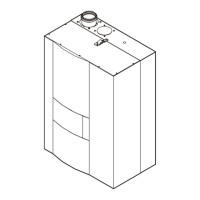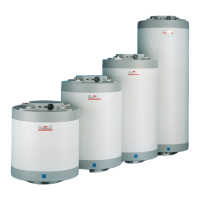23(5$7,21
This second safety system requires a automatic re-
set and generates an alarm on the boiler. The reset
button on the LGM’s control panel (item no. 8, fig. 5)
must therefore be pressed to return to normal ope-
ration.
$QWLVKRUWEXUQHUF\FOHSURWHFWLRQIXQF
WLRQ
The mimimum time that the burner can operate is
set to 60 seconds.
)XQFWLRQV DFWLYDWHG XVLQJ WKH /*0¶V
FRQWUROSDQHO
6ZHHSIXQFWLRQ
Signal code "5" on the display (item no. 4, fig. 15).
The sweeping function is activated by pressing but-
ton % for at least one second, i.e. a heating request
is made and so the system comes on. The "on-off"
functions of the internal management system re-
main inactive in this situation. Heating then operates
at maximum heat output until the boiler’s 85 °C
maximum temperature is reached (temperature
control function) so that the sweep function can
carry out combustion product evacuation measure-
ments.
7h9)XQFWLRQ
Signalling code "4" on the display (item no. 4,
fig. 16).
Pressing buttons $ and %together for at least one
second activates the TÜV function, i.e. the internal
management unit / temperature controller function
become inactive. Heating then operates at maxi-
mum output until the water or combustion product
overheating safety device responds (item no. 4 and
item no. 23, fig. 3). Releasing either of the two but-
tons interrupts the TÜV function.
/*0PDQDJHPHQWXQLWRIIIXQFWLRQ
Signalling code "7" flashes on the display (item
no. 4, fig. 17).
Pressing button $ only for at least 3 seconds activa-
tes the "LGM off" function. This makes it possible to
manually adjust the speed of the ventilator motor on
the d.h.w. temperature setting potentiometer (item
no. 1, fig. 17), and thus also the heat output (e.g. for
setting the gas valve). The module then operates in
its heating regime; the temperature controller’s in-
ternal function and the "on-off" management unit are
active.
The "LGM off" function is ended by pressing button
$ again or by switching off the burner.
4
)LJ
4
)LJ
4
1
)LJ
